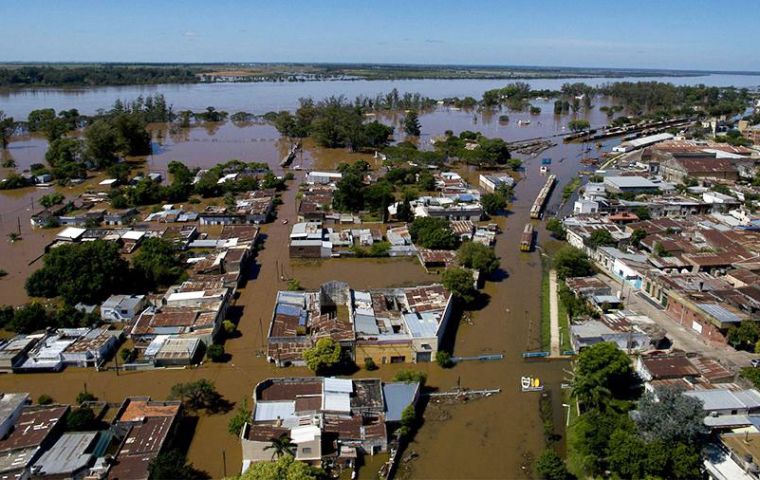MercoPress. South Atlantic News Agency
Floods and droughts mean yearly losses worth US $ 1 billion for Argentina, says World Bank
 Tackling climate change is not a long-term challenge, but an urgent measure, Schwartz said
Tackling climate change is not a long-term challenge, but an urgent measure, Schwartz said A new report titled “Impact of Climate Crisis on Poverty and the Argentine macroeconomy” points out the serious consequences of the impact of climate change on the Argentine economy, mainly due to losses caused by floods and droughts, the World Bank announced Tuesday.
The document showed that due to floods there were annual asset losses of between US $ 500 million and US $ 1.4 billion, that is, on average of US $ 1 billion annually and those losses could increase 125% as a consequence of climate change.
“An unavoidable conclusion emerges from the report: tackling climate change is not a long-term challenge, but an urgent measure given the fiscal impact, lost growth, and the costs to the most vulnerable households that already occur and are substantial,” said Jordan Schwartz, director of the World Bank for Argentina, Paraguay and Uruguay.
“Floods have been responsible for causing economic losses of about US $ 22.5 billion since 1980, as well as 58% of all economic losses caused by natural disasters between 1966 and 2015,” he added.
Climate events have a direct impact on people. Every year, as a result of floods, on average, 0.14% of the Argentine population falls into poverty, and in some provinces, this impact can exceed 1.5% after major catastrophes.
“Floods generated 'welfare losses' equivalent in 2015 to a fall of between US $ 1,500 and US $ 3,900 million and have a direct impact on the poorest families, who are the least likely to recover when disasters strike, especially in the poorest provinces,” said Julie Rozenberg, a senior economist at the World Bank.
Thence, Entre Ríos is the province with the highest average annual incidence of poverty rating at 0.15% of its population.. Behind Entre Ríos, the four provinces with the highest poverty rate resulting from natural disasters are Chaco (0.10%), Santiago del Estero (0.10%), Buenos Aires (0.08%) and Corrientes (0.08%).
Furthermore, populations with little access to public services or who receive social assistance bear a disproportionately large burden of welfare losses caused by floods. For example, beneficiaries of the Universal Child Allowance experience 40% fewer asset losses than the general population, but 25% higher welfare losses.
Argentina's agriculture is particularly vulnerable to climate change through droughts. Between 2010 and 2019, the agricultural sector represented 8.7% of GDP and an average 60% of the country's exports. Much of the tax revenue depends on agricultural exports. For example: the severe drought that Argentina suffered at the beginning of 2018 generated a 2.5% drop in GDP, along with the financial shock and depreciation of the peso that occurred from April of that year. The economic recession began in the second quarter, when agricultural production fell by 32% annually due to the severe drought and, on the demand side, exports contracted by more than 8% (also annually).
The drought of the 2008/2009 season, in the context of the international financial crisis, also affected export prices. Losses of production accounted for more than 40% of the drop in 2009, which accounted for almost 80% of the recession.
By 2050, GDP could fall by as much as 5%, and tax revenues by 10% compared to a scenario without climate change, the World Bank forecasts.




Top Comments
Disclaimer & comment rulesCommenting for this story is now closed.
If you have a Facebook account, become a fan and comment on our Facebook Page!